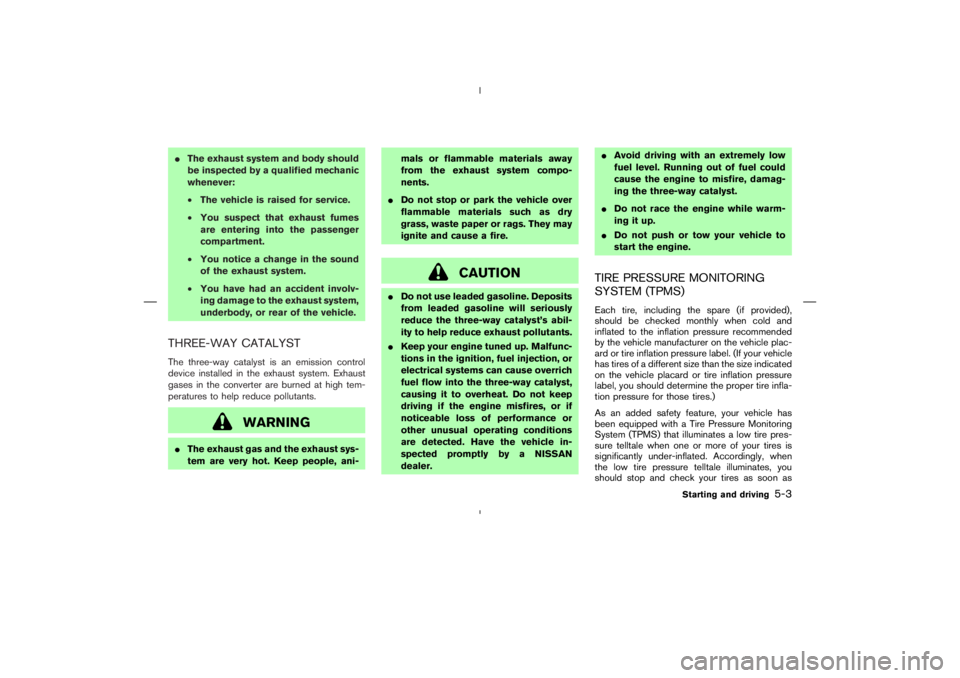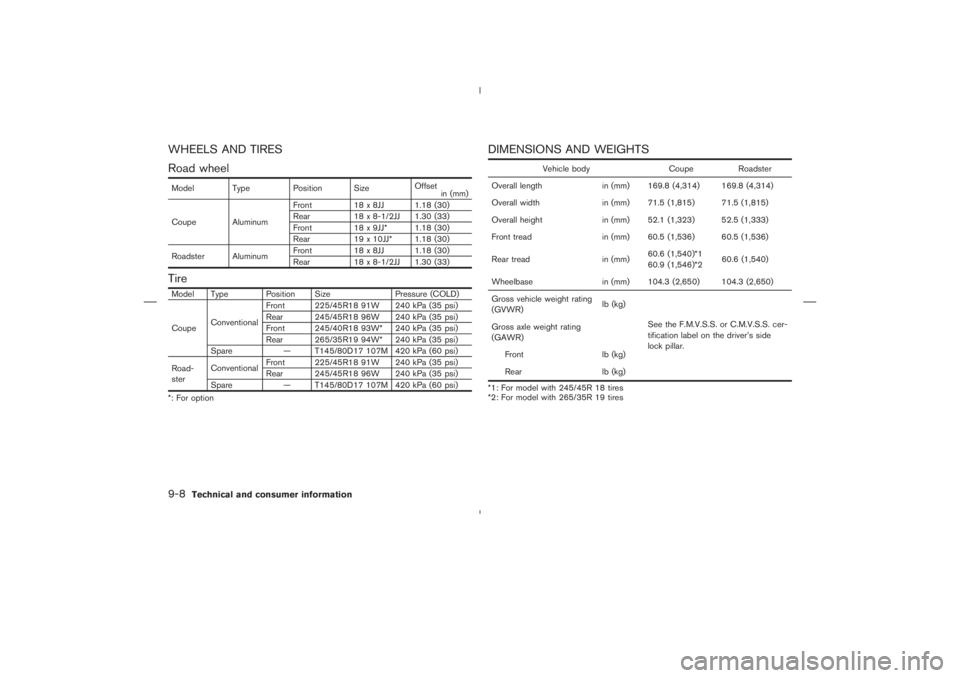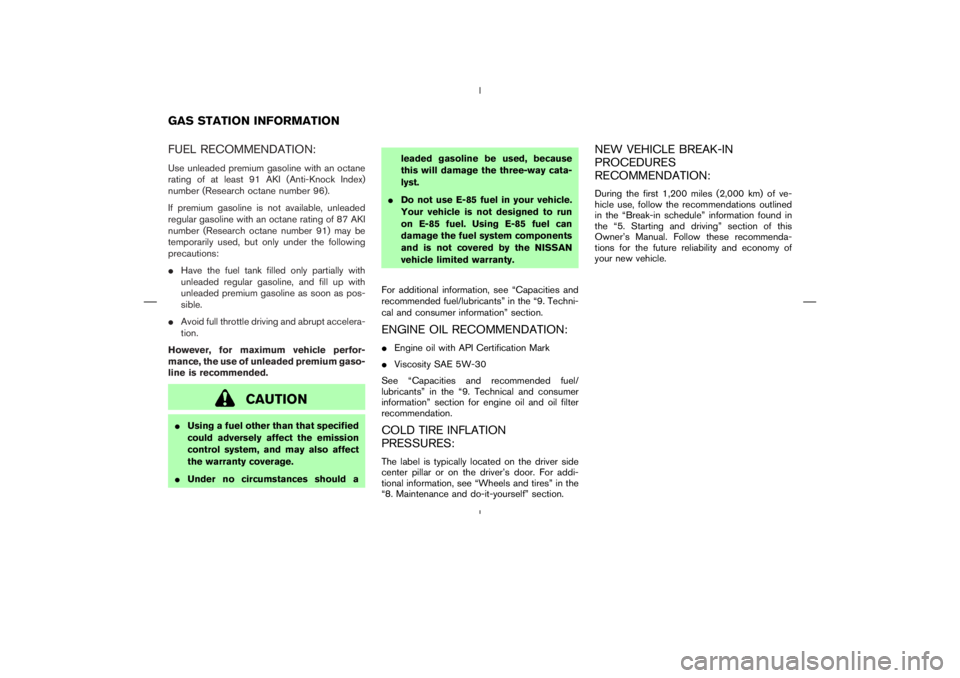Page 77 of 313

CAUTION
�The TPMS is not a substitute for the
regular tire pressure check. Be sure
to check the tire pressure regularly.
�If the vehicle is being driven at
speeds of less than 16 MPH (25
km/h), the TPMS may not operate
correctly.
�Be sure to install the specified size of
tires to the front and rear.
Seat belt warning light
The seat belt warning light and chime remind you
to fasten seat belts. The light illuminates when-
ever the ignition key is turned to ON, and will
remain illuminated until the driver’s seat belt is
fastened.
The seat belt warning light may also illuminate ifthe front passenger’s seat belt is not fastened
when the front passenger’s seat is occupied. For
5 seconds after the ignition switch is in the ON
position, the system does not activate the warn-
ing light for the front passenger.
See “Seat belts” in the “1. Safety — Seats, seat
belts and supplemental restraint system” section
for precautions on seat belt usage.
Supplemental air bag warning
light
After turning the ignition key to the ON position,
the supplemental air bag warning light will illu-
minate. The supplemental air bag warning light
will turn off after about 7 seconds if the system is
operational.
If any of the following conditions occur, the front
air bag, side air bag (if so equipped) and curtain
air bag (if so equipped), and pretensioner sys-
tems need servicing and your vehicle must be
taken to a NISSAN dealer.
�The supplemental air bag warning light re-
mains on after approximately 7 seconds.
�The supplemental air bag warning light
flashes intermittently.
�The supplemental air bag warning light does
not come on at all.
2-14
Instruments and controls
Page 188 of 313

CAUTION
�Do not use leaded gasoline. Deposits
from leaded gasoline will seriously
reduce the three-way catalyst’s abil-
ity to help reduce exhaust pollutants.
�Keep your engine tuned up. Malfunc-
tions in the ignition, fuel injection, or
electrical systems can cause overrich
fuel flow into the three-way catalyst,
causing it to overheat. Do not keep
driving if the engine misfires, or if
noticeable loss of performance or
other unusual operating conditions
are detected. Have the vehicle in-
spected promptly by a NISSAN
dealer.�Avoid driving with an extremely low
fuel level. Running out of fuel could
cause the engine to misfire, damag-
ing the three-way catalyst.
�Do not race the engine while warm-
ing it up.
�Do not push or tow your vehicle to
start the engine.
TIRE PRESSURE MONITORING
SYSTEM (TPMS)Each tire, including the spare (if provided),
should be checked monthly when cold and
inflated to the inflation pressure recommended
by the vehicle manufacturer on the vehicle plac-
ard or tire inflation pressure label. (If your vehicle
has tires of a different size than the size indicated
on the vehicle placard or tire inflation pressure
label, you should determine the proper tire infla-
tion pressure for those tires.)
As an added safety feature, your vehicle has
been equipped with a Tire Pressure Monitoring
System (TPMS) that illuminates a low tire pres-
sure telltale when one or more of your tires is
significantly under-inflated. Accordingly, when
the low tire pressure telltale illuminates, you
should stop and check your tires as soon as
Starting and driving
5-3
Page 265 of 313
SDI1401A
WHEELS AND TIRES
8-30
Maintenance and do-it-yourself
Page 266 of 313

WARNING
�Improperly inflated tires can fail
suddenly and cause an acci-
dent.
�The Gross Vehicle Weight Rat-
ing (GVWR) is located on the
F.M.V.S.S./C.M.V.S.S. certifica-
tion label. The vehicle weight
capacity is indicated on the Tire
and Loading Information label.
Do not load your vehicle be-
yond this capacity. Overloading
your vehicle may result in re-
duced tire life, unsafe operating
conditions due to premature
tire failure, or unfavorable han-
dling characteristics and could
also lead to a serious accident.
Loading beyond the specifiedcapacity may also result in fail-
ure of other vehicle compo-
nents.
�Before taking a long trip, or
whenever you heavily load your
vehicle, use a tire pressure
gauge to ensure that the tire
pressures are at the specified
level.
�Do not drive your vehicle over
85 MPH (137 km/h) unless it is
equipped with high speed rated
tires. Driving faster than 85
MPH (137 km/h) may result in
tire failure, loss of control and
possible injury.
�For additional information re-
garding tires, refer to “Impor-
tant Tire Safety Information”
(US) or “Tire Safety Informa-
tion” (Canada) in the Warranty
Information Booklet.
Maintenance and do-it-yourself
8-31
Page 283 of 313

Model Type Position SizeOffset
in (mm)
Coupe AluminumFront 18 x 8JJ 1.18 (30)
Rear 18 x 8-1/2JJ 1.30 (33)
Front 18 x 9JJ* 1.18 (30)
Rear 19 x 10JJ* 1.18 (30)
Roadster AluminumFront 18 x 8JJ 1.18 (30)
Rear 18 x 8-1/2JJ 1.30 (33)TireModel Type Position Size Pressure (COLD)
CoupeConventionalFront 225/45R18 91W 240 kPa (35 psi)
Rear 245/45R18 96W 240 kPa (35 psi)
Front 245/40R18 93W* 240 kPa (35 psi)
Rear 265/35R19 94W* 240 kPa (35 psi)
Spare — T145/80D17 107M 420 kPa (60 psi)
Road-
sterConventionalFront 225/45R18 91W 240 kPa (35 psi)
Rear 245/45R18 96W 240 kPa (35 psi)
Spare — T145/80D17 107M 420 kPa (60 psi)
*: For option
DIMENSIONS AND WEIGHTS
Vehicle body Coupe Roadster
Overall length in (mm) 169.8 (4,314) 169.8 (4,314)
Overall width in (mm) 71.5 (1,815) 71.5 (1,815)
Overall height in (mm) 52.1 (1,323) 52.5 (1,333)
Front tread in (mm) 60.5 (1,536) 60.5 (1,536)
Rear tread in (mm)60.6 (1,540)*1
60.9 (1,546)*260.6 (1,540)
Wheelbase in (mm) 104.3 (2,650) 104.3 (2,650)
Gross vehicle weight rating
(GVWR)lb (kg)
See the F.M.V.S.S. or C.M.V.S.S. cer-
tification label on the driver’s side
lock pillar. Gross axle weight rating
(GAWR)
Front lb (kg)
Rear lb (kg)
*1: For model with 245/45R 18 tires
*2: For model with 265/35R 19 tires
9-8
Technical and consumer information
Page 312 of 313

CAUTION
�Using a fuel other than that specified
could adversely affect the emission
control system, and may also affect
the warranty coverage.
�Under no circumstances should aleaded gasoline be used, because
this will damage the three-way cata-
lyst.
�Do not use E-85 fuel in your vehicle.
Your vehicle is not designed to run
on E-85 fuel. Using E-85 fuel can
damage the fuel system components
and is not covered by the NISSAN
vehicle limited warranty.
For additional information, see “Capacities and
recommended fuel/lubricants” in the “9. Techni-
cal and consumer information” section.
ENGINE OIL RECOMMENDATION:�Engine oil with API Certification Mark
�Viscosity SAE 5W-30
See “Capacities and recommended fuel/
lubricants” in the “9. Technical and consumer
information” section for engine oil and oil filter
recommendation.COLD TIRE INFLATION
PRESSURES:The label is typically located on the driver side
center pillar or on the driver’s door. For addi-
tional information, see “Wheels and tires” in the
“8. Maintenance and do-it-yourself” section.
NEW VEHICLE BREAK-IN
PROCEDURES
RECOMMENDATION:During the first 1,200 miles (2,000 km) of ve-
hicle use, follow the recommendations outlined
in the “Break-in schedule” information found in
the “5. Starting and driving” section of this
Owner’s Manual. Follow these recommenda-
tions for the future reliability and economy of
your new vehicle.
GAS STATION INFORMATION